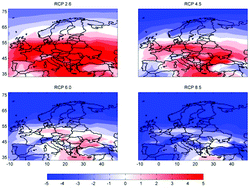Projected changes in clear-sky erythemal and vitamin D effective UV doses for Europe over the period 2006 to 2100
Abstract
The benefits and the harmful effects of solar ultraviolet radiation (

* Corresponding authors
a LATMOS – Université de Versailles Saint-Quentin-en-Yvelines, 11 Bd. d'Alembert, Guyancourt, France
b
Instituto de Recursos Naturais – Universidade Federal de Itajubá, Av. BPS, 1303 – CEP 37500-903, Itajubá, Brazil
E-mail:
mpcorrea@unifei.edu.br
Tel: +55 35 3629 1449
c LMD/IPSL – Ecole Polytechnique, Palaiseau, France
d Faculty of Medicine Paris-Ile de France Ouest, Université de Versailles Saint-Quentin-en-Yvelines, 2 Av. de la Source de la Bièvre, Montigny-Le-Bretonneux, France
e Laboratoire de Physique et Chimie de l'Environnement, Orléans Cedex 2, France
f Service de Dermatologie – Centre Hospitalier Victor Dupouy, 69 rue du Lieutenant-Colonel Prud'hon, Argenteuil, France
The benefits and the harmful effects of solar ultraviolet radiation (

 Please wait while we load your content...
Something went wrong. Try again?
Please wait while we load your content...
Something went wrong. Try again?
M. D. P. Corrêa, S. Godin-Beekmann, M. Haeffelin, S. Bekki, P. Saiag, J. Badosa, F. Jégou, A. Pazmiño and E. Mahé, Photochem. Photobiol. Sci., 2013, 12, 1053 DOI: 10.1039/C3PP50024A
To request permission to reproduce material from this article, please go to the Copyright Clearance Center request page.
If you are an author contributing to an RSC publication, you do not need to request permission provided correct acknowledgement is given.
If you are the author of this article, you do not need to request permission to reproduce figures and diagrams provided correct acknowledgement is given. If you want to reproduce the whole article in a third-party publication (excluding your thesis/dissertation for which permission is not required) please go to the Copyright Clearance Center request page.
Read more about how to correctly acknowledge RSC content.
 Fetching data from CrossRef.
Fetching data from CrossRef.
This may take some time to load.
Loading related content
